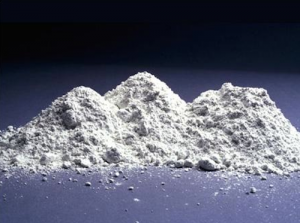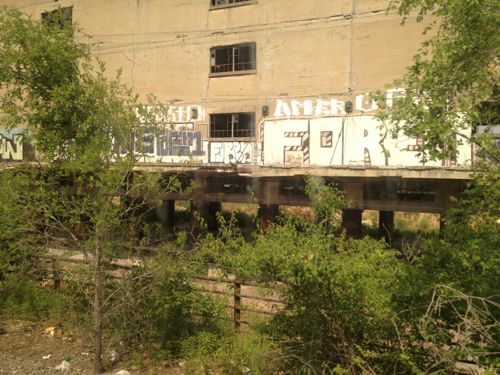The Cotton Belt Building Isn’t Made of Cement
In architecture school I had two semesters of classes on materials, so when I read sentences like the following I get irritated:

Today, the 750-foot-long face of the old Cotton Belt Rail Depot is in pretty rough shape, a wall of cracked cement and busted-out windows, with a string of graffiti wherever the taggers could reach. (stltoday)
“Cracked cement?” First, what is cement?
The common name for Portland cement, the most important modern construction material, notably as a constituent of concrete. In the manufacturing process, limestone is ground into small pieces (about 2 cm). To provide the silica (25%) and alumina (10%) content required, various clays and crushed rocks are added, including iron ore (about 1%). This material is ground and finally burned in a rotary kiln at up to 1500°C, thus converting the mixture into clinker pellets. About 5% gypsum is then added to slow the hardening process, and the ground mixture is added to sand (for mortar), gravel and crushed rock (for concrete). When water is added, the cement solidifies gradually, undergoing many complex reactions. The name “Portland” cement arises from a resemblance to stone quarried at Portland, England. (click image at right for source)
Cement is an important ingredient used to manufacture concrete, which is what the Cotton Belt building is made of.
There are three basic ingredients in the concrete mix:
- Portland Cement
- Water
- Aggregates (rock and sand)
Portland Cement – The cement and water form a paste that coats the aggregate and sand in the mix. The paste hardens and binds the aggregates and sand together.
Water- Water is needed to chemically react with the cement (hydration) and too provide workability with the concrete. The amount of water in the mix in pounds compared with the amount of cement is called the water/cement ratio. The lower the w/c ratio, the stronger the concrete. (higher strength, less permeability)
Aggregates- Sand is the fine aggregate. Gravel or crushed stone is the coarse aggregate in most mixes. (ConcreteNetwork.com)
Thus, none of the following exist:
- A cement sidewalk
- Cement blocks
- Cement silo
You get the idea…

The Rally Saint Louis project is very interesting, click here for information.
— Steve Patterson
And there is no such thing as a masonary block.
Your 4/23 blog is a shocker! Can’t imagine why a reference to “cement” vs “concrete” bothers you so much when your blogs frequently contain grammatical errors commonly found in elementary-school compositions (typically weeded out in high school, certainly in college/university), including run-on sentences, misuse of “too, to, two”, “affect, effect”, “its, it’s”…..ad infinitum. Product of St. Louis University? (I know. You have at least twice mentioned that your blog is not intended to be a scholarly endeavor!) Your PRIDE should be reflected not just in the acknowledgment and celebration of your sexual orientation, but in your communication as well, especially since you claim SLU as your alma mater and host a public blog.
Who’s being overly bothered here? 🙂
I don’t know. Do you? I attended SLU as an undergraduate student, and I can’t imagine that SLU’s reputation (whatever that may be) hasn’t been compromised. I certainly would think twice about majoring in English at SLU!
You’re such a nudge.
Btw, I reckon the “Reverend” Biondi has done more to compromise SLU’s rep than Mr. Patterson’s inadvertent spelling miscues.
Yes, I make frequent mistakes. I also have brain damage resulting from my stroke. I’ve never had any professional training in journalism and I do this as a hobby to occupy my time.
1) It ain’t “journalism”–it’s grade school grammar! 2) You don’t have to GRADUATE from a school to call it your alma mater. 3) Even if you just ATTENDED SLU and dropped out, you certainly took English 101, which in just about every school in the country exposes students to writing skills and basic grammar, even if their grade schools and high schools had somehow dropped the ball. In the better schools that offer journalism as a major, they assume the student has already been exposed to basic grammar and so they don’t typically teach fundamentals except in extreme cases. The point of the initial comment, I believe, is that most grade school students, and just about EVERY high school student, and certainly all college students should know the fundamentals of written communication! (In other words, you don’t have to have studied journalism!) Shame on SLU!
The last English course I had was the Spring of 1986, I’ve learned a lot since and forgotten quite a bit. Unfortunately, my ability to focus is selective post-stroke.
I love it. Complaining about someone’s grammar, education and alma mater while using “ain’t.” Well done!
Ever hear of rhetorical effect, Rick? I think it was quite effective, and I agree that every endeavor demands and should be given full attention.
I have heard of rhetorical effect – I guess I didn’t find it as effective as you. I’m perplexed as to why someone would feel the need to use this forum to criticize Steve’s grammar and writing style. I come here for information and entertainment, and I’m sorry I got involved in this thread. Have a great evening.
The benefit this blog creates for the St. Louis region through awareness and constructive discussion far outweighs the alleged harm it creates through occasional grammatical mistakes.
How is sexual orientation relevant here?
“Pride”–nothing more. Put on your thinking cap, Jones.
Ok so I’m just going to completely disregard comments from guest accounts, most of these are clearly coming from one person. Sissy’s, Emily’s, and Markitae’s comments have nothing to do with the post.
I think the construction industry MIGHT have planted the seed in people’s minds to use the term “cement” when “concrete” is perhaps more appropriate. In Bridgeton, MO the concrete flatwork union that provides personnel to place and finish “concrete” announces themselves as CEMENT MASONS LOCAL 527. Today, the industry often refers to these men as CONCRETE FINISHERS, but all over the country they are also equally well-known as CEMENT finishers.
Sorry, but I have to agree with Mae in that, if you’re going to host a blog, you should take the time to proofread it before hitting “send”….especially since you attended a local university and have made several references to it.
I do in fact proofread and catch many mistakes. I don’t have a degree from SLU, I was unable to finish because of my stroke.
Very interesting, thanks for the info.
I’m really excited for the Cotton Belt Mural to go up. I heard that they will let just about any St. Louisian come out and help paint, anyone know if that’s still the case?
What a great idea! Particularly considering the crowdfunding aspect.
Ignore the haters Steve. Don’t let the grammar police, and the stick-up-arse brigade, overshadow what you do on this blog.
Rally Saint Louis is interesting, as is this project. Thanks, I know I prefer knowing building materials and being ignorant about proper sentence syntax rather than the other way around.
Arguing about grammar in a thread about concrete? Come on.
This thread sums up exactly why STL is where it’s at. Focusing and fighting about the little things while ignoring the bigger picture. Well done. Stay on task people!